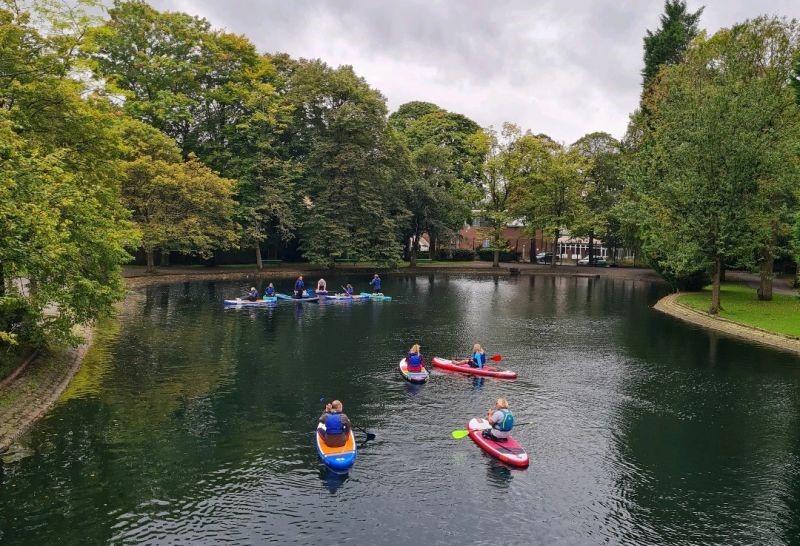Ever found yourself wobbling on a paddleboard, trying to stay upright while the ripples seem to knock you off balance? Maybe it was your first time, or maybe you just got too confident. Either way, you learned quickly: control when you’re on a paddleboard is a myth (at least it is for me!), and responsiveness is everything. Turns out, paddleboarding isn’t just a test of balance – it’s a masterclass in systems leadership.
At Miova, we believe leadership isn’t about staying in control; it’s about learning to move with complexity. It’s about sensing, adjusting, and sometimes falling in with style. Paddleboarding has given me, and some of the leaders we’ve worked with, ten wet but important lessons that apply just as well in council chambers, community networks, or cross-sector partnerships, as they do out on the water.
Let me explain.
1. Balance is Dynamic
Forget perfect posture. Paddleboard balance is about constant micro-adjustments. It’s not a state you can ever quite reach; it’s more a dance. Systems leadership is the same. It asks us to stay open, nimble, and responsive, adjusting our position as new information, relationships, and tensions emerge.
Donella Meadows wrote that “the future can’t be predicted, but it can be envisioned and brought lovingly into being.” That starts with learning to shift weight in real time. And if you wait for still waters to act, you might never leave the shore. This dynamic nature echoes what systems thinkers call self-organisation – the capacity of a system to reconfigure itself without central control. Like your body learning to adapt on the board, systems can evolve when given the both the space, but also importantly the support.
2. Look Up and Out
If you look at your feet while paddleboarding, I’ve learned from experience that you inevitably fall in. Looking up seems to help you find your bearings, spot patterns in the waves, and move with confidence. Systems leaders need that same panoramic view. Instead of fixating on isolated problems, we’re scanning the horizon – mapping relationships, sensing system behaviour, and locating leverage points.
The iceberg model is a helpful example: above the surface, we see events and outcomes. But below, patterns, structures, and mental models shape what happens. Leaders who look only at the waterline miss most of what’s really happening in the system.
In the Blackpool physical activity system, we’ve been working with leaders, helping them not to ask, “how do we get more people exercising?” but to explore the more nuanced questions of, “how do place, poverty, relationships, social norms, housing, and trust shape people’s likelihood to be active?” That shift in perspective changed everything.
3. Go Slow to Go Far
When you try to power through choppy water, you get tired, fast. Smooth paddlers know that pacing is vital. Systems change is a long-term process. It asks us to resist the lure of urgent fixes and invest in steady, relational, cumulative progress. Play the long game.
Peter Senge described systems thinking as a discipline for “seeing wholes.” At Miova, we often work with leaders who feel the pressure to deliver now – but when they slow down, connect, and learn together, they go further. It’s critical that we resist the pressure for fast results and hold our nerve – and often, we need support from others to give us the cover and confidence to focus on long-term, sustainable change.
This principle is reflected in how living systems grow. Trees don’t sprint; they respond to seasons. Coral reefs don’t build overnight; they emerge over decades. Systems leadership respects that kind of tempo – attuned to conditions, relationships, and timing.
4. Your Stance Shapes Your Stability
Too narrow and you’ll topple. Too wide and you can’t move. On a paddleboard and in leadership, your stance matters. In systems leadership, your stance means how you show up: how you listen, what you prioritise, and where you position yourself in the system.
One system leader we coached realised their instinct to “lead from the front” was often getting in the way. They experimented with leading from the side – supporting others to lead and creating space for more shared ownership. That shift made the wider team of partners more engaged, more stable and agile. Just like adjusting your feet on the board.
It’s also a question of power dynamics. Who gets to speak, to act, to rest? Your “stance” can either centralise control or distribute leadership across the system.
5. The Wind and Water Have Their Own Ideas
You can’t control the elements. You work with them. Likewise, in complex systems, external forces will always impact our plans. Sensemaking becomes more important than strategy.
This reminds me of Dave Snowden’s Cynefin framework, where the complex domain requires probing, sensing, and responding. Systems leaders don’t fix the system; they seem to be able to tune into it. In paddleboarding we need to adjust our paddle angle, the direction of our stroke, even how we distribute our weight to account for the tide, current or the wind.
The socio-ecological model also comes into play here. It reminds us that individual behaviour is shaped by interpersonal, organisational, community, policy-level influences as well as social norms and ideological world views. What feels like a headwind might actually be a structural current we’ve failed to see.
6. Falling is Part of the Learning
Everyone ends up in the water. The trick is to fall well, laugh, and get back up. In complex systems, failure isn’t a disaster, it’s feedback.
One leisure trust CEO we worked with piloted a neighbourhood physical activity model. It didn’t land as hoped. But by surfacing what didn’t work and involving local partners in the analysis, they redesigned a far more effective approach. Systems thinking helped turn an early setback into forward motion.
As Russell Ackoff once said, “We fail more often because we solve the wrong problem than because we get the wrong solution to the right problem.” Falling in the right direction can be much more useful than relentlessly pursuing solutions to the wrong question.
7. Keep Your Paddle in the Water
Steering requires engagement. You can’t coast and influence at the same time. Likewise, systems leadership is not about watching from the shore. It’s about being in the water, contributing, listening, and adjusting.
At Together an Active Future in Lancashire we’ve learned that being in the water is key. We’ve tried to co-design, co-lead, and co-own the work with partners and communities. That relational involvement has enabled real influence.
This is emergence in action: new patterns of behaviour and coordination emerging through participation, not planning. When leaders stay engaged, the system has more opportunities to evolve.
8. Smooth Strokes Beat Splashy Effort
Thrashing around makes waves – but not progress. It’s the quiet, consistent strokes that move you forward. Systems leadership values depth over drama.
As Meadows reminds us, “leverage lies in understanding the system structure.” That understanding grows slowly, through patient observation, learning, and reflection. It doesn’t always make headlines, but it makes a difference.
Some of the most powerful leverage points aren’t flashy. They might be changing information flows, building trust, or questioning goals. That takes intention and patience. Small shifts are often more useful than big splashes.
9. You Can’t Paddle Alone for Long
Sure, a solo trip is peaceful. I love being on the water on my own for a while. But in rough water or long journeys, you need people around you. Not only because it isn’t very safe otherwise, but being with others also allows you to have more fun, as well as making the experience easier by taking turns to lead and break the waves. Similarly, systems change takes collective action.
That’s why we help place-based partnerships build distributed leadership: not one hero paddler, but a flotilla. For example, in our work with Bristol, we worked across the Bristol Active City Network – local anchors, community groups, clinicians and citizens paddling together, each with their own strength, shared direction, and interdependence. Working with just the council, or just the Active Partnership could never have unlocked the potential that sits in the network.
Systems leadership thrives in what Frieze calls the “below the green line” work – building relationships, holding space, and cultivating new possibilities under the radar. It’s the network of quiet connectors, system weavers, and those pushing at the edges that create the conditions for systems to grow.
10. The Still Moments Matter
Some of my most powerful moments on a board have happened when I pause, float, and just breathe. The same is true in systems leadership. You’ve got to find time to think.
Stillness isn’t stagnation. It’s space to reflect, to listen deeply, and to sense the system. In our strengths coaching, we often help leaders recognise the value of these moments: to move from action into awareness. That’s where insight lives.
Systems are alive. They speak, if we pause to listen. And often, what they need isn’t more effort, it’s more attention.
So, what does paddleboarding teach us about systems leadership? That it’s less about mastering the waves and more about learning to move with them. It teaches us to look up, to find rhythm, to lead with others, and to stay open to the surprises of the water.
Whether you’re in a wetsuit or a workshop, those lessons seem to hold up. And more than that, they remind us that leadership isn’t about heroic paddling, it’s about presence, perspective, and partnership.
Next time you’re facing complexity, ask yourself: what would a paddleboarder do?
#SystemsLeadership #MiovaMoments #LeadingWithTheFlow

